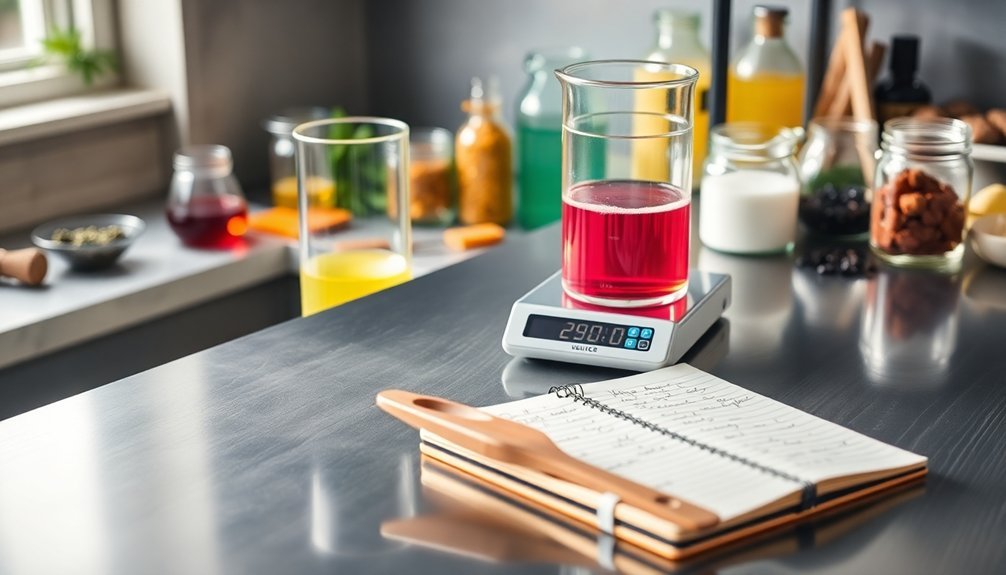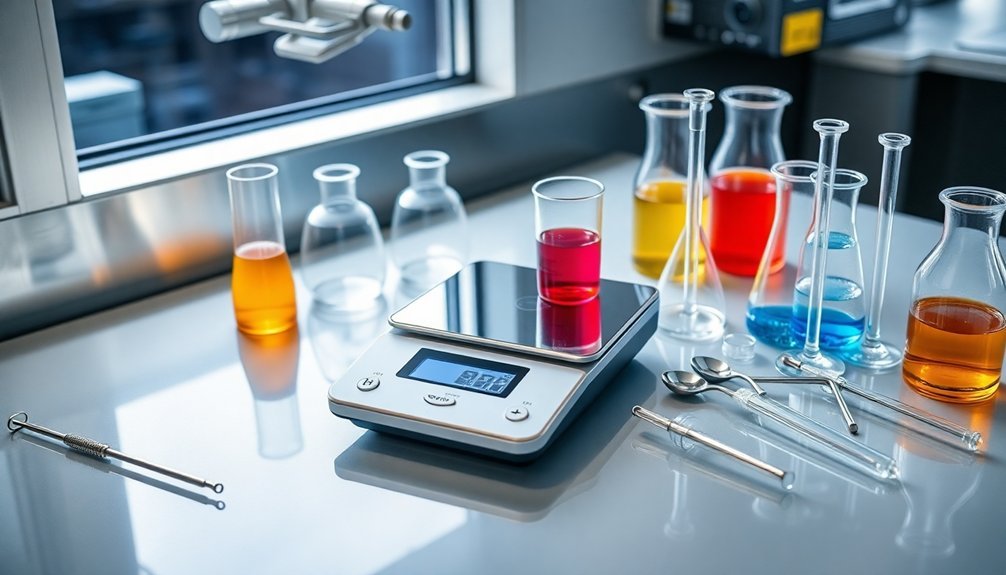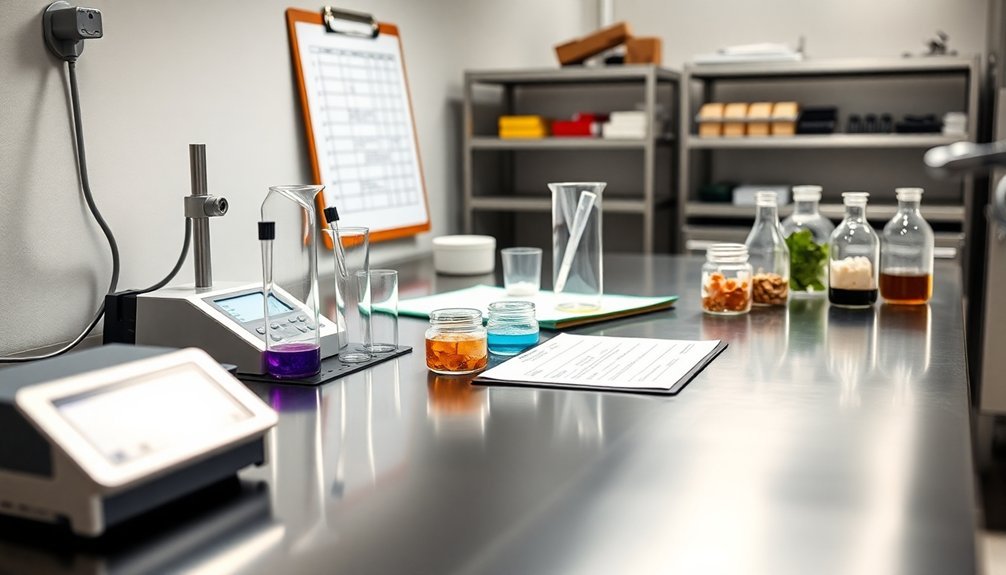When measuring ingredients for cold process soap, always use weight instead of volume for accuracy. You'll need a digital scale that measures to 1/10th of an ounce or gram to guarantee proper chemical reactions during saponification. Keep oils and lye solution between 95°F-105°F for ideal trace development. Document every measurement, temperature, and observation in a standardized template. This systematic approach transforms soap making from an art to a reliable manufacturing process you can perfect with each batch.
Measuring Your Batch: Cold Process Manufacturing Guide

Diving into cold process soap making requires precise measurements to guarantee success. When crafting your soap, accurate measurements of oils, lye, and water are absolutely critical—recipes are typically provided in ounces for consistency and precision.
As a beginner, start with a test batch size of 8 ounces (1/2 pound) of oils. This manageable quantity allows you to experiment with different ratios while facilitating proper scaling for future larger batches.
Always use an online lye calculator to determine the correct amount of lye and water based on your specific oils. Keep your lye solution and oils between 95°F and 105°F during mixing for ideal trace development.
Remember to document each step of your batch measuring process—this practice helps refine your technique and guarantees consistent results with every soap you make.
Weight vs. Volume: Understanding Measurement Fundamentals
While many cooking recipes rely on volume measurements, successful soap making depends entirely on weight measurements for consistent results.
Unlike kitchen recipes that measure in cups and spoons, precision soapmaking requires weight measurements to ensure safe, consistent results every time.
When you're measuring ingredients for soap, understanding the weight vs. volume distinction is vital for precision.
Ounces can refer to both weight and volume, creating potential confusion in soapmaking. Remember that oils, butters, and other ingredients have different densities, meaning a cup of olive oil weighs differently than a cup of coconut oil.
Even water, which equals 8 ounces by weight per cup, should be measured by weight rather than volume for accuracy.
Always use a digital scale when measuring your ingredients. This guarantees the proper chemical reactions occur during saponification, leading to balanced, safe soap with predictable qualities.
Essential Equipment for Precise Batch Measurements

Every successful soap maker relies on a core set of measurement equipment for consistent results. Your first investment should be a precise scale that measures to 1/10th of a gram or ounce, essential for accurately weighing oils and lye solution components.
For measuring containers, select Pyrex or stainless steel options that won't react with lye.
Never overlook safety equipment—rubber gloves and safety goggles are non-negotiable when handling caustic ingredients during batch measurements.
Choose soap molds based on volume capacity that accommodates your entire batch without overflow.
Finally, implement smart workspace organization with clearly labeled containers for ingredients. This systematic approach minimizes measurement errors and creates an efficient workflow, allowing you to focus on perfecting your soap formula rather than searching for supplies.
Scaling Your Recipe: Mathematics of Batch Sizing
With your measurement equipment properly set up, you're ready to tackle batch calculations with mathematical precision.
Scaling your recipe requires careful attention to ingredient ratios and proportions—never simply guess!
To scale effectively, multiply or divide your original recipe by the desired batch size factor. Always base your calculations on total oil weight, then adjust water and lye amounts accordingly.
For beginners, start with test batches of 8 ounces (227g) of oils, using approximately 2.26 oz water and 1.13 oz lye.
When doubling or tripling recipes, maintain precise ratios while considering adjustments to superfat percentages for consistent results.
Online lye calculators can help guarantee accurate adjustments for any batch size. Remember that all ingredients must still total 100% regardless of scale to maintain your soap's desired properties.
Test Batch Strategies for Product Development

Before scaling up to full production, smart soapmakers develop their formulations through strategic test batches. Start with manageable quantities—either 4 oz (1/4 pound) or 8 oz (1/2 pound) of oils—to perfect your cold process soap recipes efficiently.
A balanced test formulation typically includes 8 oz (227 g) oils, 2.26 oz (64 g) distilled water, and 1.13 oz (32 g) lye.
Structure your oil blend with approximately 50% olive or rice bran oil, 31% coconut oil, 6% castor oil, and 13% butter for ideal results.
Calculate essential oils at 1/4 tsp per 4 oz of base oils to maintain consistent scent profiles.
Document every aspect of your soapmaking process—temperature changes, trace development, and curing observations—to refine your formulation.
These detailed records will become invaluable when you're ready to scale your successful test batches to full production.
Density Considerations When Working With Diverse Ingredients
Measuring your soap ingredients by weight rather than volume eliminates the errors caused by varying densities across different materials.
You'll find that oils like palm (density 0.89 g/ml) occupy different volumes despite having identical weights, which can drastically affect your final product's properties.
Keeping an ingredient density chart handy will help you make quick conversions when needed and guarantee your cold process soap formulations remain consistent batch after batch.
Weight Vs Volume Variations
Although both weight and volume measurements use ounces in common parlance, they're fundamentally different concepts that can greatly impact your soap formulation.
When crafting soap, you'll want to prioritize weight measurements for consistent results. Different ingredients have varying densities—like palm oil at 0.89 g/ml—meaning a fluid ounce doesn't equal a weight ounce across all materials.
- Weight measurements guarantee accurate proportions regardless of ingredient density
- Volume measurements can lead to inconsistent saponification results
- Even minor measurement discrepancies can greatly affect final soap quality
- Oils and additives each have unique densities that affect their weight-to-volume ratio
- Using a digital scale eliminates guesswork in your soapmaking process
Remember that precision in measurements translates directly to the quality and consistency of your finished soap bars.
Ingredient Density Charts
Consistency in your soap formulations depends heavily on understanding ingredient densities. When converting between volume and weight measurements, remember that different ingredients occupy varying amounts of space despite having the same mass.
For example, palm oil (0.89 g/ml) requires 1.13 fluid ounces to equal 1 ounce by weight.
Always rely on weight measurements rather than volume when formulating your soap recipes. Visual volume assessments can lead to significant errors, especially with oils that have different densities.
Keep an ingredient density chart handy for quick reference. This precision becomes even more critical when scaling recipes for larger batches or adjusting for different molds.
Documentation Practices for Consistent Manufacturing

You'll need to document each batch meticulously, including precise measurements of oils, lye, additives, and any formula adjustments to guarantee replicability.
Adopt a standardized template that captures critical variables like date, temperatures, mixing conditions, and superfat percentages to streamline your record-keeping process.
Regular review of these documented batches will help you identify patterns that improve your manufacturing consistency and ultimately enhance product quality.
Documentation Practices for Consistent Manufacturing
When creating cold process soap, meticulous documentation serves as the backbone of consistent manufacturing. Your records will become invaluable resources for replicating successful batches and troubleshooting any issues that arise.
- Record precise ingredient weights and measurements, including any modifications to your formula.
- Document temperatures of both your lye solution and oils at mixing time to understand how thermal variables affect outcomes.
- Note observations throughout the curing process, tracking color changes and scent retention.
- Implement a standardized template to guarantee you're capturing all essential information systematically.
- Track success rates across batches, recording environmental factors like humidity and ingredient sources.
This systematic approach to documentation transforms your soap making from an artistic endeavor into a reliable, repeatable manufacturing process that improves with each carefully documented batch.
Standardized Record Templates
A well-designed record template transforms scattered notes into actionable manufacturing data.
Your templates should include dedicated fields for batch size, oil weights, lye calculations, and water percentages to guarantee consistency across different production runs.
Document all oils and additives with their exact weights and percentages to maintain precise formulations you can replicate later.
Include sections for observations during the soapmaking process—track color changes, scent retention, and texture developments as your soap cures.
Always record measurements in consistent units (preferably weight) to eliminate confusion and improve accuracy.
By implementing standardized record templates, you'll develop a systematic approach that reveals trends in your soap's performance.
This organized documentation helps you identify what works, what doesn't, and what adjustments will enhance future batches.
Frequently Asked Questions
How Many Bars of Soap Does One Batch Make?
You'll typically get 8-10 bars from a standard 2-pound batch, but it varies based on your mold size and desired bar weight. A 1-pound batch yields 4-5 bars, while a 5-pound batch makes 20-25 bars.
How Do You Make 30 30 30 Soap?
To make 30 30 30 soap, you'll combine equal parts (30% each) of three oils like coconut, palm, and olive. Calculate your total oil weight, use a lye calculator, mix at 95-105°F, then cure for 4-6 weeks.
What Is the Math for Making Soap?
To make soap, you'll calculate lye using a saponification calculator based on your oils' weight. Maintain a 2:1 water-to-lye ratio and add 5-8% extra oils for superfatting. Always weigh ingredients precisely for consistent results.
How to Calculate the Weight of Soap?
To calculate your soap's weight, add the total weight of your oils, lye, and water. You'll lose about 5-7% during curing due to evaporation, so your final soap weight will be slightly less than this sum.
In Summary
You've now mastered the essentials of measuring cold process batches. Remember, accuracy isn't just about precision—it's the foundation of your product's quality and consistency. Always double-check your measurements, keep detailed records, and don't hesitate to run test batches when scaling. With these skills, you'll confidently transform your formulations into reliable, reproducible products that meet your standards every time.





Leave a Reply